Like the endless Bleak Expanse that she hails from, Iyslander has become nigh inescapable. As one of the latest heroes in the game, she’s fresh on the minds of both new players buying their first packs and veterans that have drafted her. She commands one of the most unique playstyles, widely appealing to Wizards, control players, and value-oriented thinkers. She’s also one of the strongest heroes in the game, coming hot off of a World Championship victory piloted by Michael Hamilton. As such, many players both novice and adept are interested in learning how to play the ice queen.
However, Hamilton’s Worlds-winning list clocks in at a whopping $1,100 USD, which is inaccessible to all but the most hardcore of Spikes and fortunate players with excess disposable income. Luckily, Iyslander can be played on just about any budget - with some compromises in card choices. We’re going to explore what the deck looks like in its simplest form, and how you can upgrade it step-by-step into a fully powered, tournament-winning eighty cards.
The Barest Bones
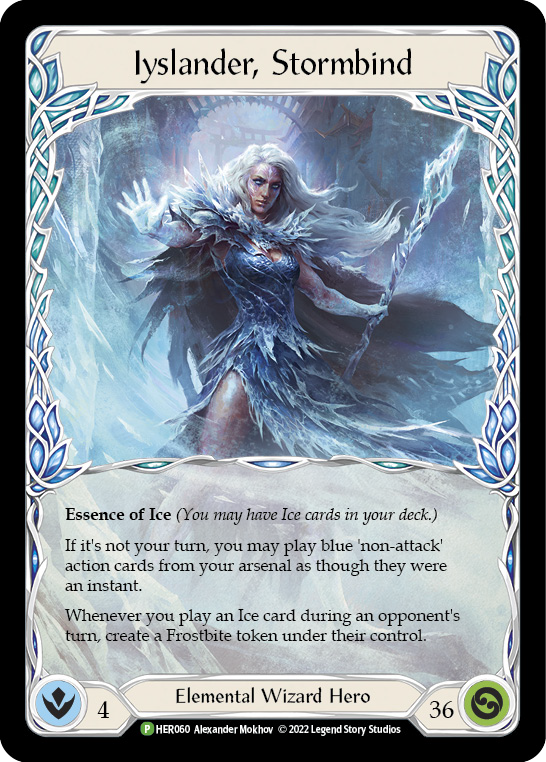
Weapons
- Waning Moon (1)
Equipment
- Ironhide Helm (1)
- Nullrune Gloves (1)
- Ironhide Legs (1)
- Nullrune Hood (1)
- Nullrune Boots (1)
- Spellfire Cloak (1)
- Ironhide Gauntlet (1)
Loadout
- Amulet of Ice (Blue) (3)
- Frosting (Blue) (3)
- Brothers in Arms (Blue) (3)
- Ice Eternal (Blue) (3)
- Isenhowl Weathervane (Blue) (3)
- Cold Snap (Blue) (3)
- Arctic Incarceration (Blue) (3)
- Aether Hail (Blue) (3)
- Icebind (Blue) (3)
- Aether Icevein (Red) (3)
- Aether Icevein (Yellow) (3)
- Aether Icevein (Blue) (3)
- Polar Blast (Blue) (3)
- Ice Bolt (Blue) (3)
- Brain Freeze (Blue) (3)
- Emeritus Scolding (Blue) (3)
- Sink Below (Red) (3)
- Scar for a Scar (Red) (3)
- Fyendal's Fighting Spirit (Red) (3)
- Winter's Bite (Blue) (3)
- Wounded Bull (Red) (3)
- Barraging Brawnhide (Red) (3)
- Winter's Grasp (Blue) (3)
- Icy Encounter (Blue) (3)
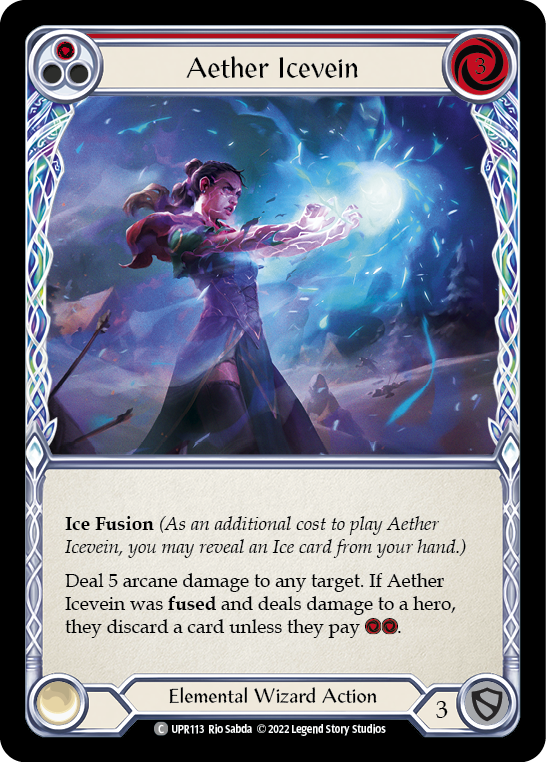
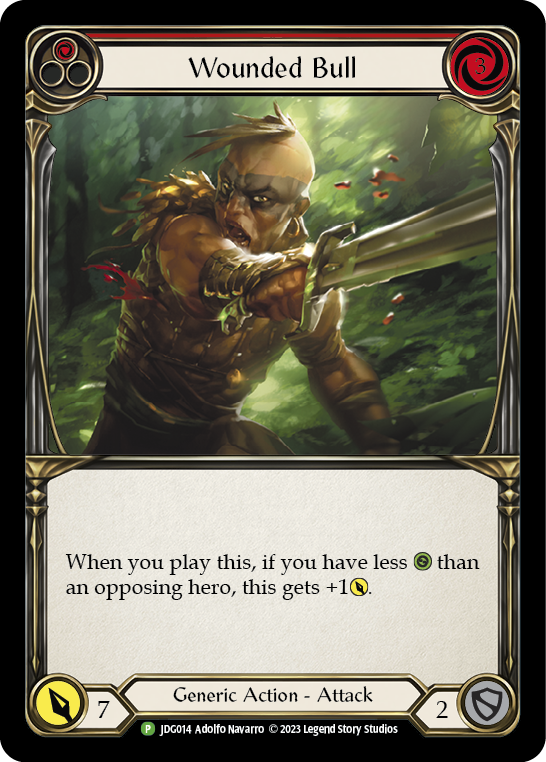
Entirely comprised of just tokens, commons, and rares, this deck is as budget as Iyslander can be while maintaining a coherent game plan. We fully embrace the “Bully” package here, as we intend to play a hyper-efficient attack on our turn like Wounded Bull or fuse an Aether Icevein to push arcane damage and disrupt our opponent. Then we go into our opponent’s turn with a blue non-attack action in arsenal and disrupt them with a frostbite to mitigate their damage output as we leak Waning Moon’s arcane damage through their defenses.

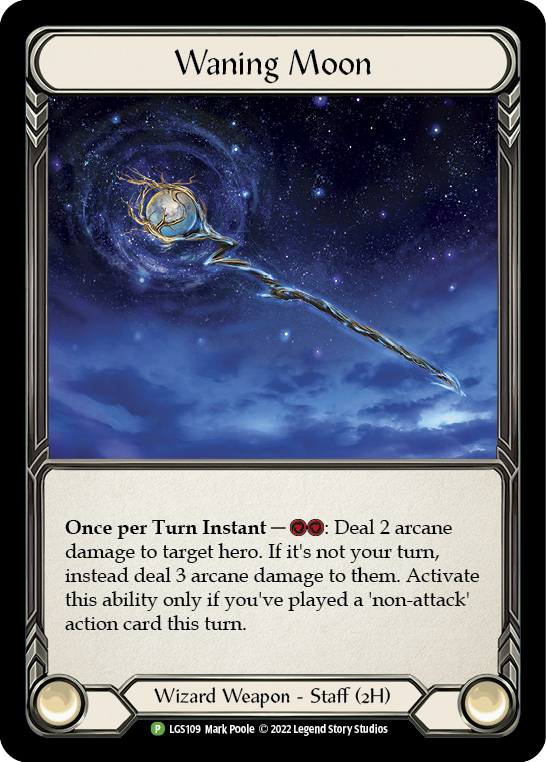
Without our usual legendary equipment, we opt for a highly defensive Ironhide suite to help survive until the late game, where the goal is to kill the opponent with a blue Emeritus Scolding from arsenal plus Waning Moon on their turn when their shields are down and they’re below 8 life.
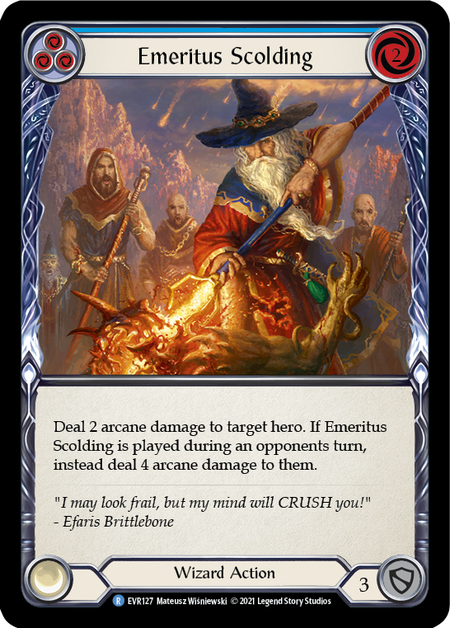
This scrappy list won’t be winning any events, but it’s an excellent way to gently introduce you to the tempo playstyle with minimal monetary investment. It’s also a fine choice for kitchen table play against other ultra-budget decks. These 81 cards (hero token included) clock in at just under $19 before shipping, and the only cards worth more than a dollar are Nullrune Gloves and Sink Below; there’s a good chance that you can get most if not all of these cards for free from your friendly local player with more bulk than they know what to do with.
Amount invested in this step: $20
Total spent: $20
Adding the One-Turn Kill
Editor's Note: We won't embed every decklist along the way - the article would get too busy quickly - but we'll be sure to highlight the additional cards you'll need to acquire. Follow the links to view the full decklists discussed!

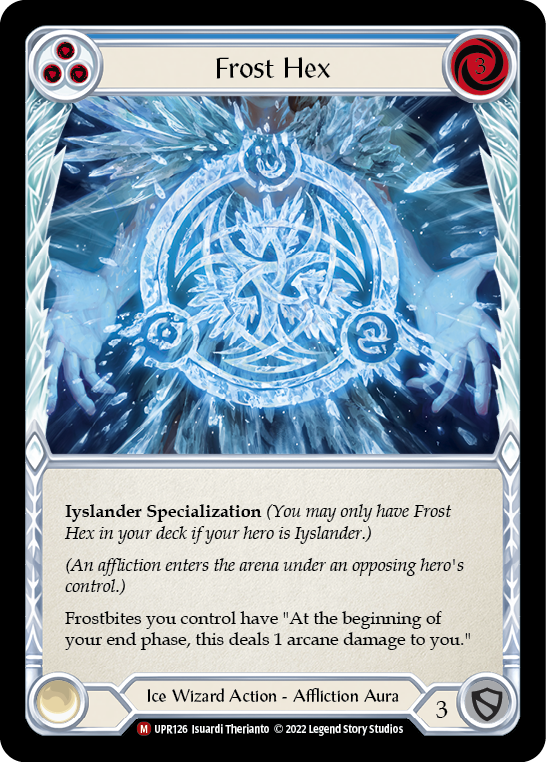
When Frost Hex was first spoiled, I immediately started brewing. Frost Hex combined with Ice Eternal promised a new combo, where three Hexes under your opponent’s control and a big Ice Eternal for X = 6 fueled by 3 blues and 2 Energy Potions could threaten up to 27 damage in a single turn. With their hand stripped of resources thanks to Amulet of Ice, such a combo was theorized to be an excellent way to close out games against opponents with too many blues to easily push arcane damage, such as Guardians.
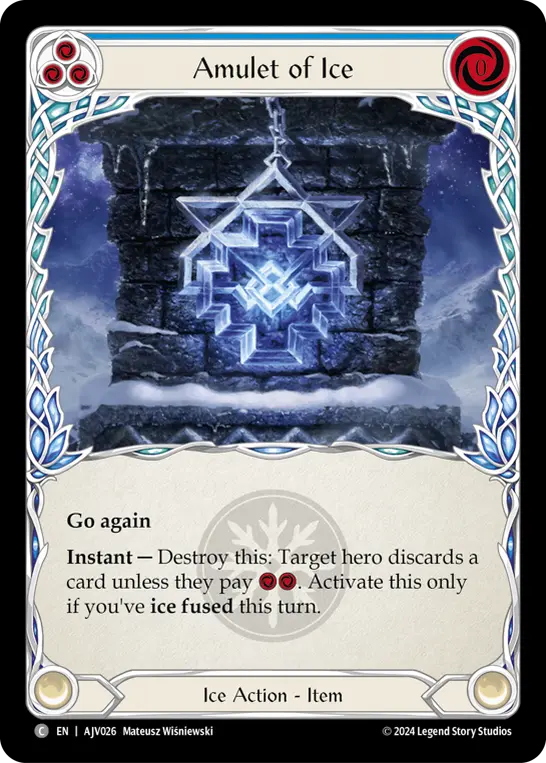
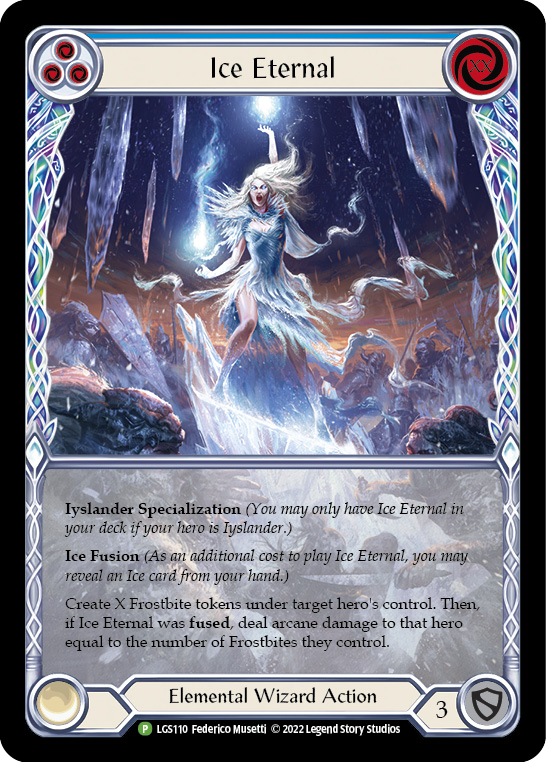
Over the course of the 2022 Road to Nationals season, it dawned on players around the world that this combo was, in fact, too good. Guardians had no way to avoid it if they attempted to fatigue Elemental Wizards, and so they were forced to adopt an aggressive stance, intending to end the game before the full combo could be assembled. Fully realized semi-one-turn-kills (semi-OTKs) are rare nowadays, but smaller versions of the combo with just two Hexes or with an easier to achieve X = 5 Ice Eternal are still relevant as game-enders - especially against Dromai, where we are unable to cash in most of our attack actions for damage, as they are needed to defend Dragons with Phantasm.
We need two cards to facilitate this plan: Frost Hex - which provides the actual damage for the kill by charging unbroken Frostbites with arcane potential - and Energy Potions - which help grease the wheels of combo turns and create larger X values of Ice Eternal. Combined, these 5 cards should run you about $15. To make room for them, we take out 2 Icebind and 3 Winter’s Grasp. Blue Icebind is passable as a blue non-attack action that blocks 3, but it’s ultimately unexciting and not an ice card, so it’s the first card to be cut. Winter’s Grasp similarly is a blue, Ice, and blocks 3, but it doesn’t do anything. Attacking with a vanilla 2 for 4 is a great way to surrender tempo, and you often want to arsenal ice cards revealed to Aether Icevein, which Winter’s Grasp is a poor candidate for given its lackluster stat line, so it’s the second cut to make in the deck.
Amount invested in this step: $15
Total spent: $35
Supplementing Both Strategies
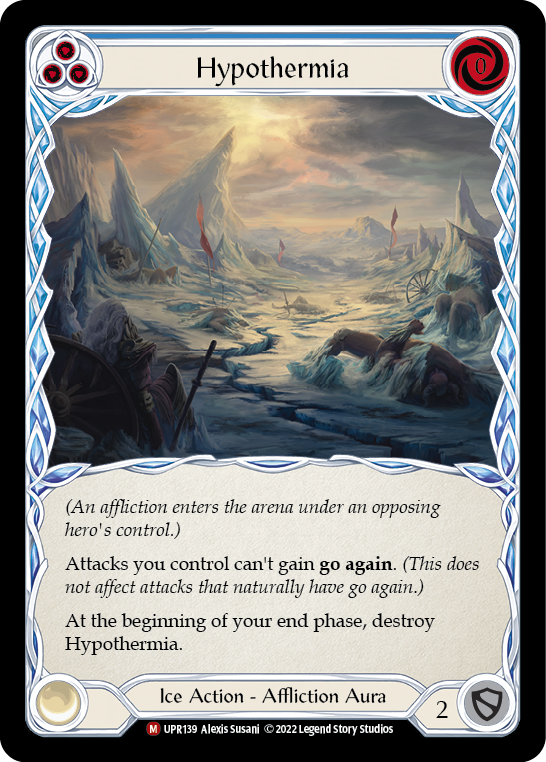
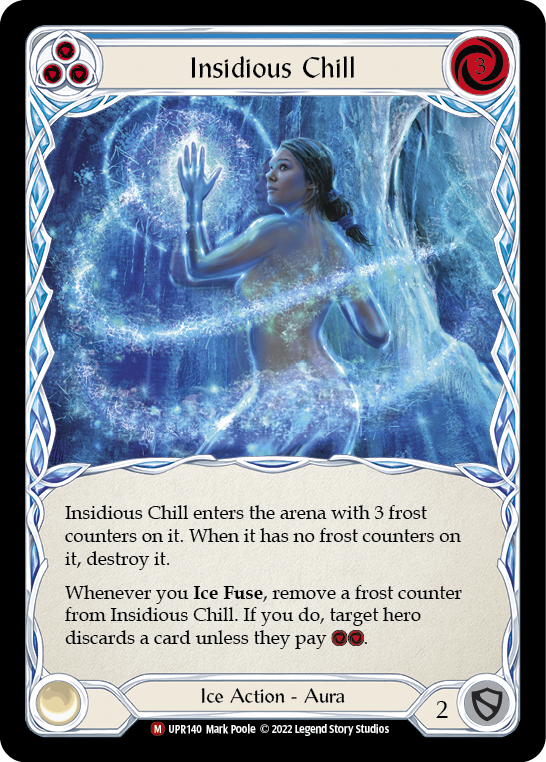
With both the Tempo and OTK game plans assembled, the next upgrade is obvious, as it complements both strategies well. Insidious Chill is simply an all-star in Iyslander. It plays nicely with Tempo by enhancing Aether Iceveins via demanding an extra card from your opponent the next three times you Ice fuse. It also pulls double duty when you’re working towards an OTK, where the Frost counters can be used to keep you alive through disrupting your opponent or saved for the final kill to deny any hopes of pitching to arcane barrier and stopping the icy onslaught.
While we’re adding impactful Ice cards that are easy on the wallet, we might as well include Hypothermia. “Hypo” is one of Iyslander’s biggest blowout cards, as it’s able to stop your opponent’s go-wide turn dead in their tracks if they’re relying on unnatural go again, such as Dash’s boosting or Briar’s Embodiments of Lightning. While Michael played two copies in his Worlds list, we’re opting for three given how good Hypo is against Dash, which is seeing a resurgence thanks to powerful cards it gained in Dynasty.
Combined, these 6 cards should again cost about $15. It’s recommended to buy the OTK package before this one, as these cards don’t increase the power of your deck on their own, but instead synergize with the OTK and tempo packages. To make room for them, we’ll cut the last copy of Icebind, as well as Icy Encounter, which is another underwhelming attack (but at least offers some disruption compared to Winter’s Grasp). Lastly, we cut 2 copies of Isenhowl Weathervane, which was included as a blue Ice non-attack action that is costed well to work with Waning Moon and allows for occasional high roll turns when it precedes a fused Icevein.
Amount invested in this step: $15
Total spent: $50
Your First Legendary

Weapons
- Waning Moon (1)
Equipment
- Coronet Peak (1)
- Nullrune Gloves (1)
- Ironhide Legs (1)
- Nullrune Hood (1)
- Nullrune Boots (1)
- Spellfire Cloak (1)
- Ironhide Gauntlet (1)
Loadout
- Amulet of Ice (Blue) (3)
- Frosting (Blue) (3)
- Brothers in Arms (Blue) (3)
- Channel Lake Frigid (Blue) (3)
- Energy Potion (Blue) (2)
- Ice Eternal (Blue) (3)
- Cold Snap (Blue) (3)
- Aether Hail (Blue) (3)
- Aether Icevein (Red) (3)
- Aether Icevein (Yellow) (3)
- Aether Icevein (Blue) (3)
- Hypothermia (Blue) (3)
- Polar Blast (Blue) (3)
- Ice Bolt (Blue) (3)
- Brain Freeze (Blue) (3)
- Emeritus Scolding (Blue) (3)
- Insidious Chill (Blue) (3)
- Sink Below (Red) (3)
- Frost Hex (Blue) (3)
- Scar for a Scar (Red) (3)
- Fyendal's Fighting Spirit (Red) (3)
- Winter's Bite (Blue) (1)
- Wounded Bull (Red) (3)
- Barraging Brawnhide (Red) (3)
- Blizzard (Blue) (3)
At this point, we’ve cleaned up most of the sub-par main deck cards, and are ready to invest in our first piece of Legendary equipment. The choice between Coronet Peak and Storm Striders is very difficult. Both are important for a fully-powered Iyslander deck, and they should be top priorities if you have the budget for both of them. However, there are a non-zero number of games that end with unspent Storm Striders simply because I didn’t need them to win - while I can’t think of any examples where I presented Coronet Peak and didn’t activate it at least once in that game. For that reason, combined with the interest of offering the most “bang for your buck” affordable upgrade path, I’m going to recommend Coronet first - but know that it’s a close call.
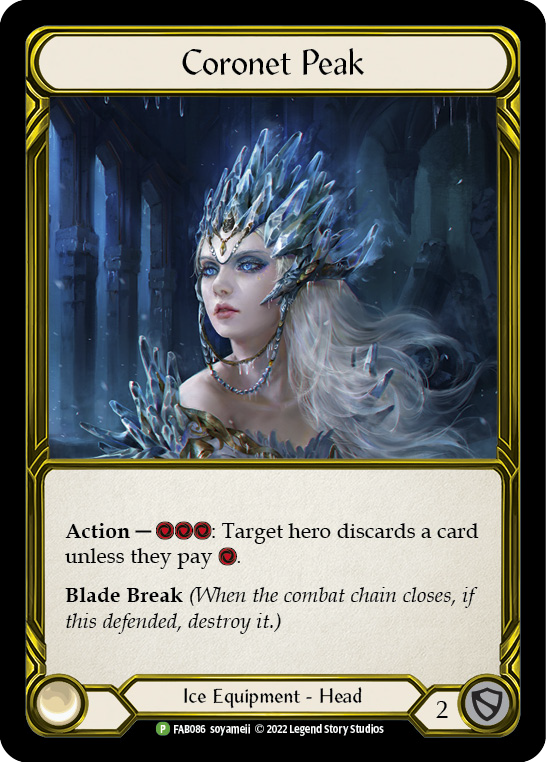
It’s time to improve our equipment package. It’s time for a Legendary. It’s time for Coronet Peak.
Coronet is the perfect Legendary on-ramp, offering a profound upgrade over Ironhide Helm. With blade break, you don’t need to pay to block with Coronet, already making it a superior option. However, the real power lies in its activated ability. As a deck that plays a plethora of blues, there are frequent quad-blue hands you may draw that lack any meaningful damage output on your turn. Coronet Peak lets you convert one of those blues into hand disruption for the low price of an action point, which you weren’t going to use on an offensively underwhelming card like Frosting anyway. Taking a card from your opponent via Coronet’s tax frequently mitigates their turn’s output by 3-4 damage. Considering that cards in our deck range from 0 to 3 block value, it’s essentially a strict defensive upgrade for the pitched card.
The power of Coronet Peak can’t be understated, and essentially every competitively successful Iyslander list has employed it to great effect.
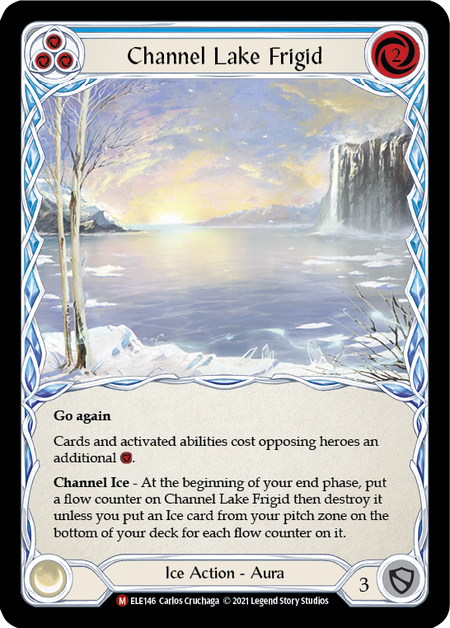
With Coronet Peak added, Iyslander’s single most powerful disruption piece is ready to be included. Channel Lake Frigid (CLF) is at its best in Iyslander, who can cheat it out from arsenal on her opponent’s turn to get a free pass on the first flow trigger, essentially prolonging the Lake’s life by one turn cycle. CLF is already one of the strongest disruptive cards in the game without considering Iyslander; with her ability, it’s simply monstrous.
There are two reasons we’ve waited until now to add it to our deck. First, it’s monetarily expensive, but we’ve upgraded essentially every other optimal cheaper option available. Second, the most common play pattern with CLF is to play it on our opponent’s turn and then pitch a blue ice card on our turn to Coronet, to satisfy the flow requirement for CLF. Without our new legendary equipment, keeping CLF for more than one turn gets tricky.
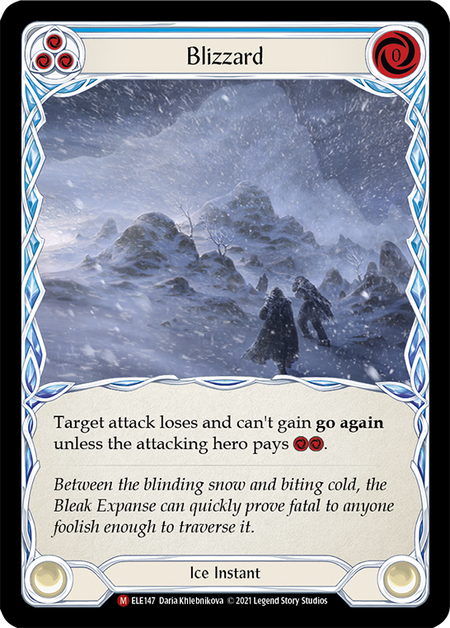
We finish off our non-equipment disruptive upgrades with the addition of Blizzard, a staple sideboard option against go-wide aggro. Blizzard works where Hypothermia can’t, able to shut down go again on cards that natively have the ability if their controller can’t afford the resource tax. Blizzard is also unique in that it’s one of the few Ice cards we can play from hand to get free frostbites on our opponent’s turn. While it’s certainly a useful card and solidly earns its place in the list, it’s not the most exciting, and players with especially tight budgets may want to hold off on investing in Blizzard until after they pick up Storm Striders, which we’ll talk about next.
Coronet Peak is the single most important card in this section, and will run around $35 for its cheaper rainbow foil version. Channel Lake Frigid is expensive for a majestic (another indicator of its raw power and ubiquity across Ice decks), coming in at $20 apiece. Lastly, a playset of Blizzard should be around $30. We’re obviously cutting Ironhide Helm to make way for Coronet. We also drop the last copy of Weathervane, the playset of blue Arctic Incarceration, and 2 Winter’s Bite to make room for our new Ice cards.
(The singleton remaining copy of Winter’s Bite is going to stay in for a while as a fantastic budget option for a later singleton card. Bite is the strongest blue card that most fully powered decks don’t run, as it offers a 2 resource tax when played on our opponent’s turn and opens up tricky lines with its go again when played on our turn.)
Amount invested in this step: $125
Total spent: $175
Becoming a Real Wizard
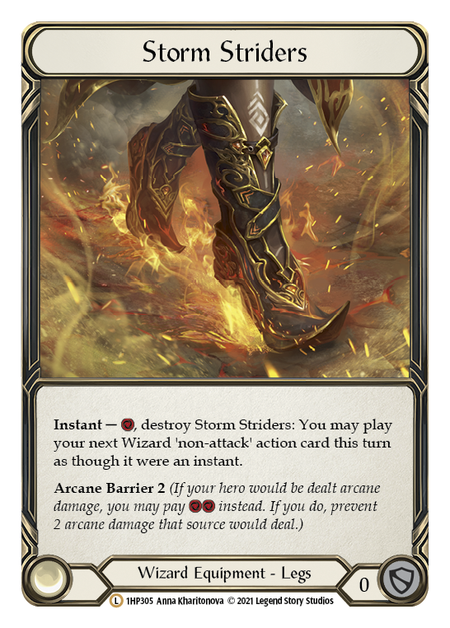
If Coronet Peak is the marquee Legendary of Iyslander’s Essence of Ice, Storm Striders is what unlocks her full potential as a Wizard. The ability to instant out a Wizard non-attack action from hand on your opponent’s turn nearly doubles the life total at which you can surprise kill your opponent from. Striders is close to saying “take an extra turn,” and will win you games where you otherwise have no outs. Their inclusion is near-mandatory for anyone interested in putting up competitive results with Iyslander, and they should be high on your list of cards to pick up… when you have the spare cash. At a cool $120 for their cheapest printing, they aren’t exactly easy on the wallet.
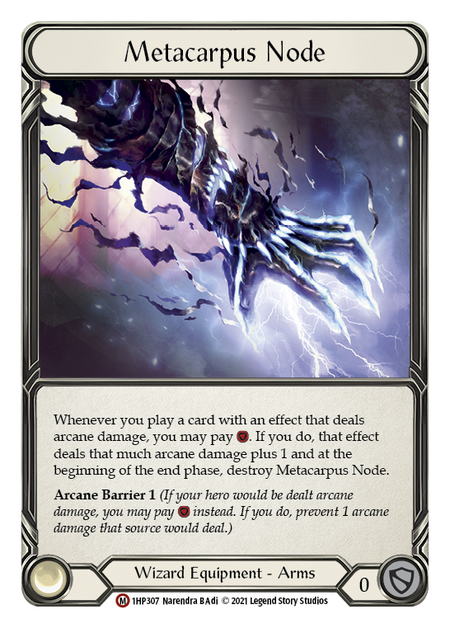
Metacarpus Node is a mild upgrade over Nullrune Gloves, as it can be used throughout the game to stop arcane damage and then cashed in late for +1 damage on a spell or two. It shines brightest against Dromai, where it helps push the limits of what your arcane spells can handle when a must-kill dragon hits the board and you have no attack actions in hand. The mild nature of this upgrade compared to some of the flashier legendaries is reflected in the price of Node; you should be able to pick one up for around $15.
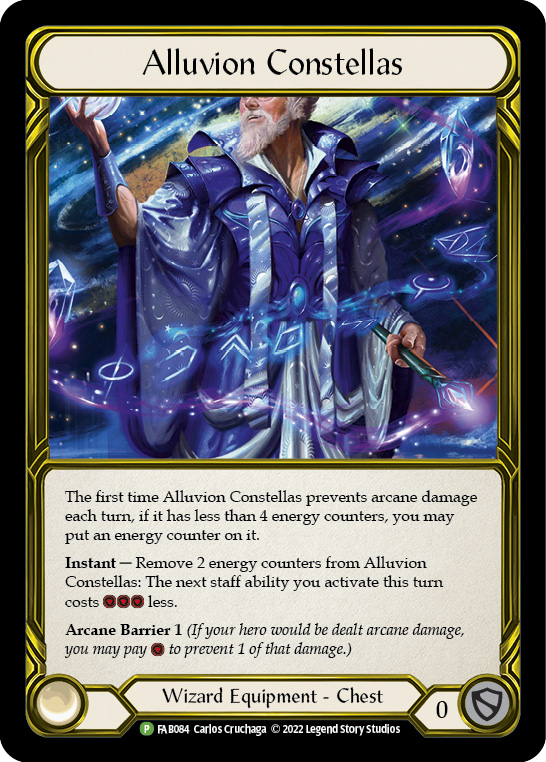
The final puzzle piece in Iyslander’s optimal Arcane Barrier load out is Alluvion Constellas. While useless against physical heroes, Alluvion provides ridiculous value when your opponent consistently threatens arcane damage. Two counters on Alluvion means you spent 2 resources to stop 2 damage, and that your next Waning Moon is free - essentially, you’re getting 5 damage for 2 resources, without spending any cards. Alluvion also has particular utility in the Iyslander mirror, as it allows tricky instant shenanigans that let you break single frostbites without spending any resources. At $30, it’s a nice upgrade and doesn’t break the bank as badly as other Legendary equipment.
Striders single-handedly replaces both Ironhide Legs and Nullrune Boots, which means that a spot is freed up in the 80 that Alluvion slots nicely into. Lastly, Metacarpus is an obvious replacement for Nullrune Gloves, as it’s a strictly superior option.
Amount invested in this step: $165
Total spent: $340
The Big One
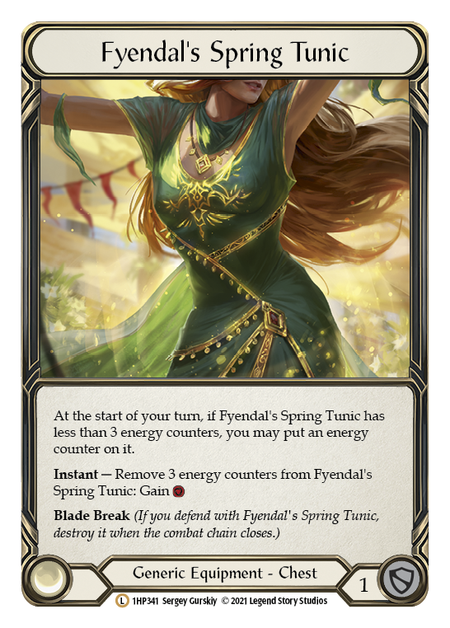
This upgrade is a single card, both because it’s that powerful and because it goes for that much on the secondary market. As the single most ubiquitous card in the game, Fyendal’s Spring Tunic needs no introduction. In Iyslander, it is incredibly flexible, smoothing out a variety of hands that are light on resources. Its most common use case is enabling a 2-cost blue card to be played from arsenal and Waning Moon to be activated using only a single blue pitch card, which keeps an extra card in hand for defense or offense compared to pitching two cards.
Tunic’s price is known to fluctuate, and is currently pushing $200 despite the recent History Pack reprint. If you can afford the investment, you’ll have a powerful legendary equipment that slots into just about any deck in the game, Iyslander included. In our list, we’re replacing Spellfire Cloak. The Cloak plays a similar role to Tunic as a free resource during our opponent’s turn, but the null defense value and single-use ability makes it an easy swap for the more powerful Legendary.
Amount invested in this step: $200
Total spent: $540
A Minor Upgrade

Let’s take a break from Legendaries to fix a sub-optimal attack that’s been lingering in our list. Barraging Brawnhide is a fine card and is similar to Wounded Bull when you’re playing against aggro decks that don’t like blocking, but it loses its shine when your opponent is okay with putting two cards down in front of it. Enlightened Strike is a powerful upgrade, as it’s a 3-block at its floor. Flexibility between go again, 7 power, and drawing a card means that it’s almost never bad to have E-Strike in hand, and it’s a welcome addition to the deck. Given its generic status and powerful utility, a playset will cost a pretty penny (or around $150).
Amount invested in this step: $150
Total spent: $690
The Other Big One
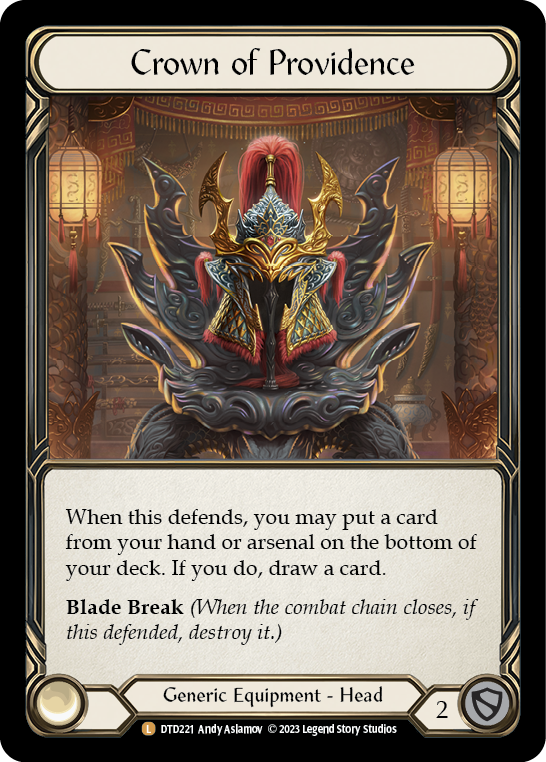
From the moment Arcane Rising released, Arcanite Skullcap was the de facto head equipment for any competitively serious deck… until Uprising introduced Crown of Providence. Providence offers unconditional 2 block, much like Coronet Peak, but its ability to fix a dud hand by “sinking” a card is vastly different. Crown sees play in matchups where you didn’t want to activate Coronet anyways – namely, against Oldhim, who has Crown of Seeds and Fyendal’s Spring Tunic to mitigate 1 resource taxes. Additionally, Providence can save you from a telegraphed Command and Conquer + Pummel combo by evacuating your arsenal card during blocks.
In Iyslander, which already has access to Coronet, Providence is a “gravy” card: useful, but only necessary if you really want to be 100% optimal, and otherwise probably not worth the investment. In our list, it replaces Nullrune Hood, as we already have access to Arcane Barrier 4; if you’re more afraid of Wizards than Oldhims, it’s perfectly valid to pass on Providence and keep the Hood, especially considering the Crown’s price tag of $150 for the rainbow foil.
Amount invested in this step: $150
Total spent: $840
The Fabled End

Weapons
- Waning Moon (1)
Equipment
- Coronet Peak (1)
- Crown of Providence (1)
- Alluvion Constellas (1)
- Fyendal's Spring Tunic (1)
- Ironhide Gauntlet (1)
- Storm Striders (1)
- Metacarpus Node (1)
Loadout
- Amulet of Ice (Blue) (3)
- Enlightened Strike (Red) (3)
- Frosting (Blue) (3)
- Brothers in Arms (Blue) (3)
- Channel Lake Frigid (Blue) (3)
- Energy Potion (Blue) (2)
- Ice Eternal (Blue) (3)
- Cold Snap (Blue) (3)
- Aether Hail (Blue) (3)
- Aether Icevein (Red) (3)
- Aether Icevein (Yellow) (3)
- Aether Icevein (Blue) (3)
- Hypothermia (Blue) (3)
- Polar Blast (Blue) (3)
- Ice Bolt (Blue) (3)
- Brain Freeze (Blue) (3)
- Emeritus Scolding (Blue) (3)
- Insidious Chill (Blue) (3)
- Sink Below (Red) (3)
- Frost Hex (Blue) (3)
- Heart of Fyendal (Blue) (1)
- Scar for a Scar (Red) (3)
- Fyendal's Fighting Spirit (Red) (3)
- Wounded Bull (Red) (3)
- Blizzard (Blue) (3)
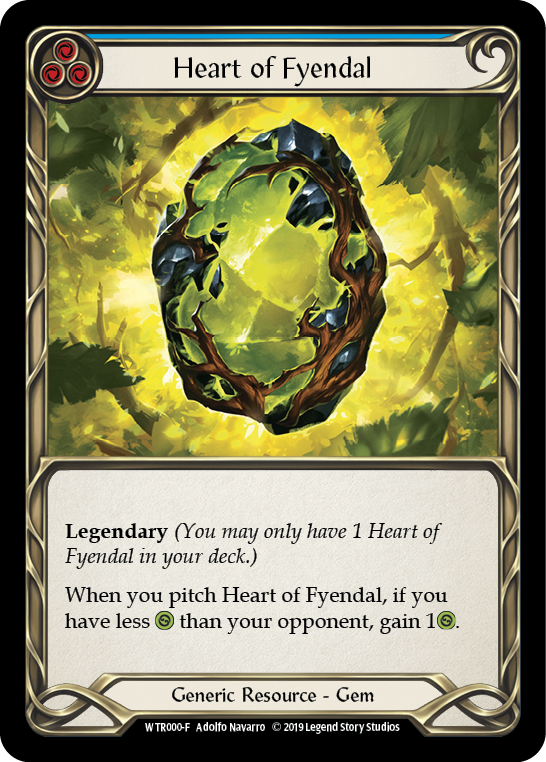
Finally, there’s one truly fabled card that would be remiss to exclude from a discussion about upgrading Iyslander decks: Heart of Fyendal. Arguably moreso than any other hero, Heart shines brightest in Iyslander where you anticipate both being lower life than your opponent for the majority of the game and pitching blues every turn cycle. Heart pulls double duty by generating resources and gaining life simultaneously, both things that Iys loves doing. While Heart is inarguably useful in Iyslander, it’s another gravy card and provides an incredibly marginal benefit for a heavy monetary cost. It can also make some hands awkward, as it can’t block and it’s suicide to arsenal unless you have Crown of Providence equipped.
At nearly $300, Heart is the single most expensive card you can invest in as an Iyslander player. If you do opt to pick up a Heart of Fyendal, swap it out for that trusty singleton copy of Winter’s Bite I mentioned a while ago.
Amount invested in this step: $280
Total spent: $1120
And that’s it! You’ve upgraded your $20 starter deck into a list ready to take on the World Championship with 8 simple steps.
Jokes aside, there’s no one right way to build Iyslander, let alone one definitive way to upgrade a budget list over time. Feel free to swap the order of any of these steps if you’re especially eager to pick up Storm Striders and start slinging spells, or if you already own a Tunic, etc. Iyslander is an incredibly versatile, fun, and challenging hero, and I hope that this article helps many players both new and old to pick her up on their own terms and start playing some truly great games of Flesh and Blood.
Today's Pro Series article was offered up free to our readers, but subscribers also have the option to listen to this piece in audio format, professionally narrated by our amazing audio team. Pro Series articles represent the best work of our best authors, and showcase a depth and attention to detail that stands out in written FaB content.
If you enjoyed this article; if you're looking for more in-depth content; if you'd like to experience our audio narration; or if you simply want to support the work we do here at the Rathe Times, consider becoming a subscriber!
In a surprising turn of events, Michael Hamilton rode a Wounded Bull to victory at the US Nationals. Go in depth with the strategy and matchups of this unexpected Iyslander deck.
Clay explains the theory behind Michael Hamilton's Worlds-winning deck and shows you how to put it to use in your own play
Rhea Adams sets out on an icy path from the Bleak Expanse to Nationals, seeing strong prospects for the Elemental Wizard.
by: Mark Chamberlain & Rhea Adams
Combining arcane damage with icy control, Iyslander brings a dynamic playstyle to the table. Learn the basics of the Elemental Wizard, from fusions to frostbite to freeze.
by: Shahmir Samee
Spatium by Keys of Moon | Music promoted by Chosic | Attribution 4.0 International (CC BY 4.0)










